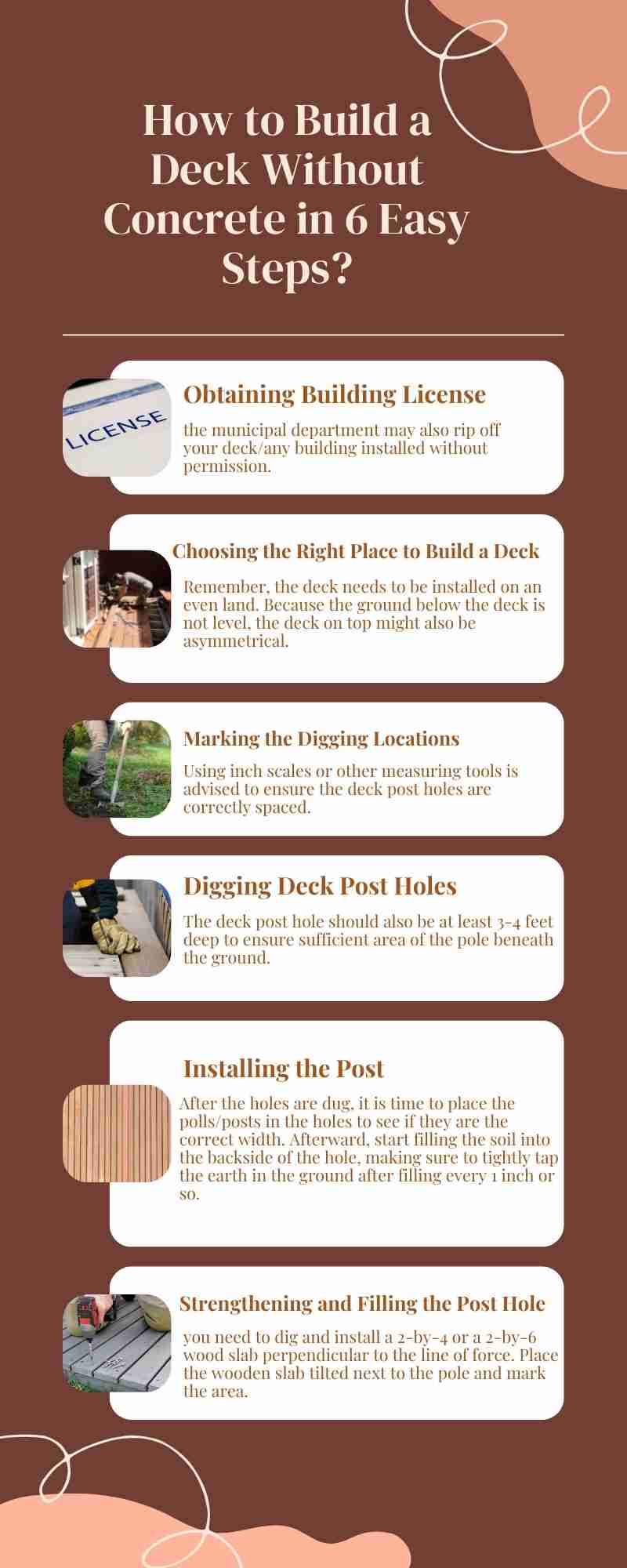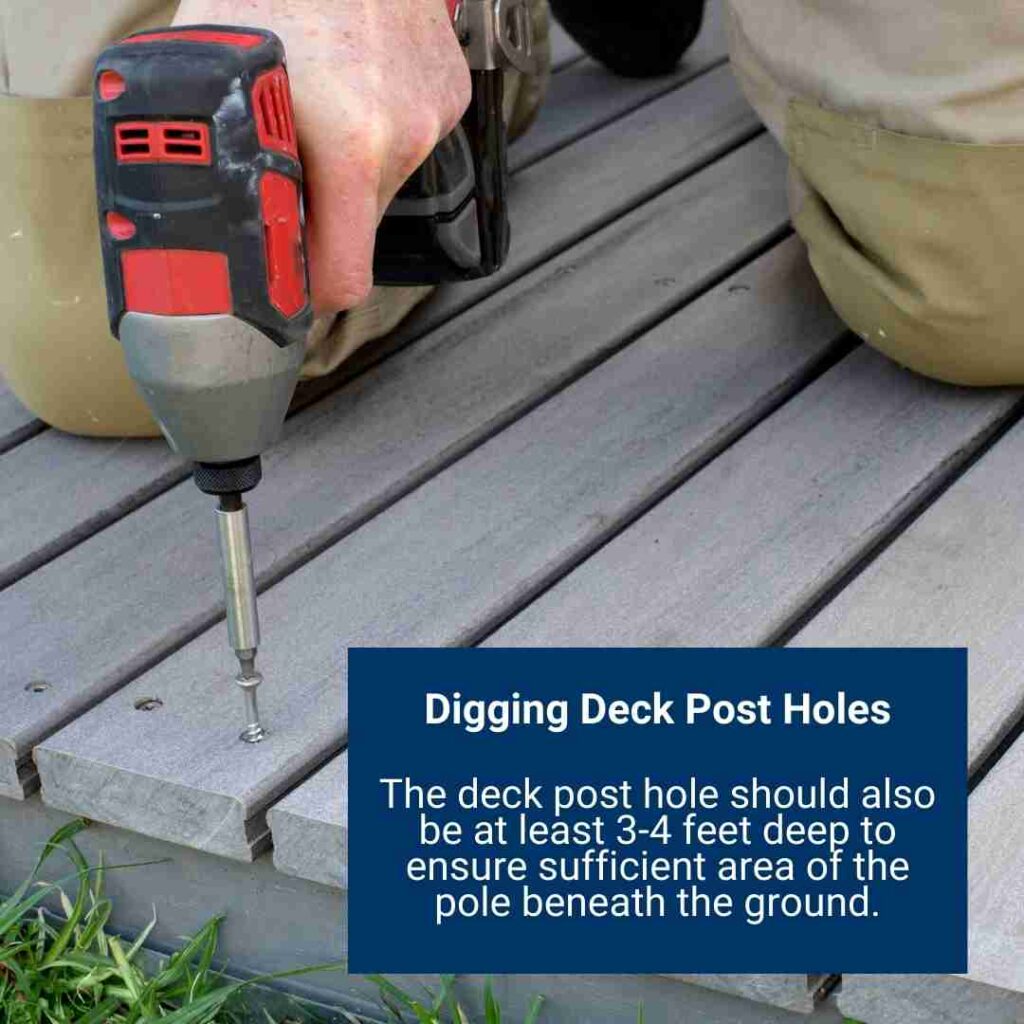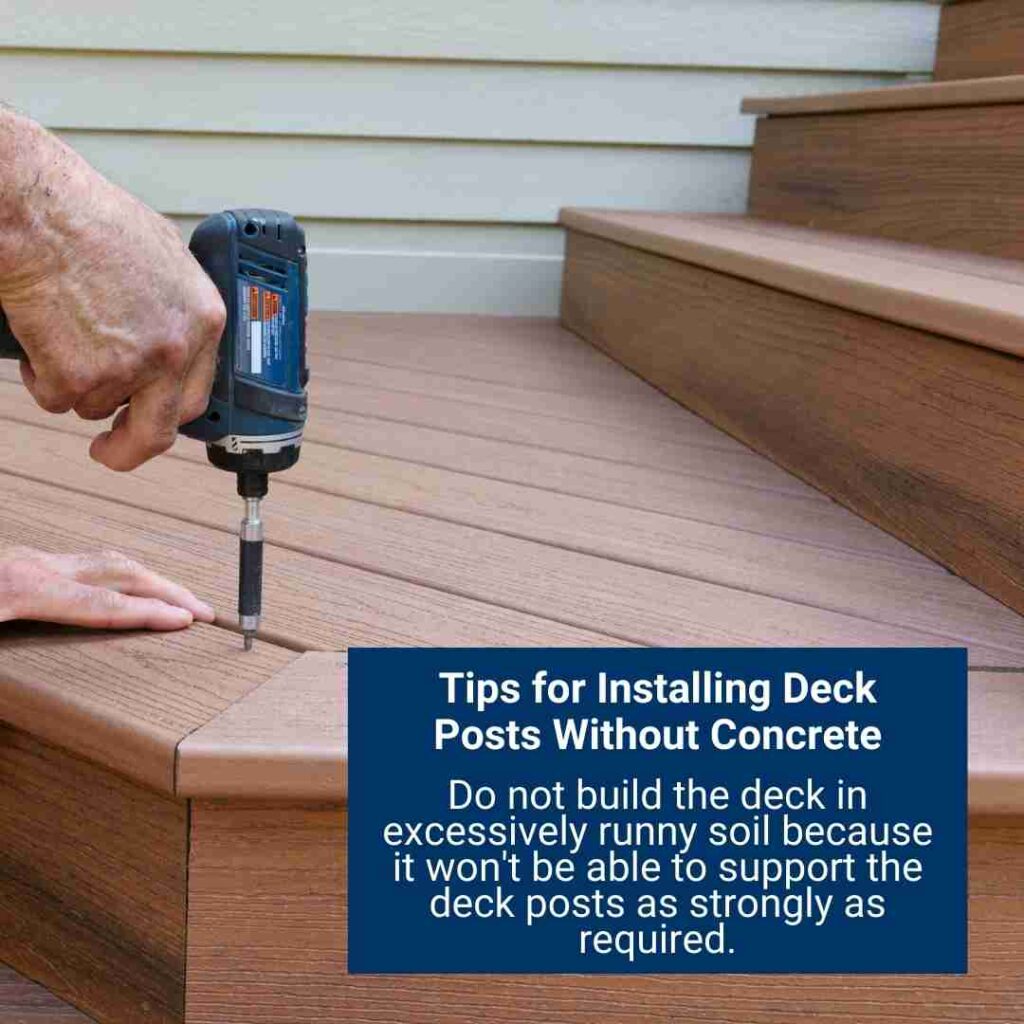Concrete is the main material used to strengthen the foundation of the deck post. So, building a deck without using concrete might seem absurd to you, especially if you are new to building decks. It might seem impossible to build a solid foundation for deck posts without using any concrete. So, you might wonder, how can you build a deck without using concrete?
You can install a deck post without concrete using a simple and easy method. You have to dig holes a bit wider than the circumference of the post and bury some wooden beams next to the post for further support. But when installing deck posts without concrete, it is crucial to ensure the posts stand firm in the ground.
If you don’t install the deck posts carefully, they might lift due to the excessive pressure causing you to spend tons of money on repairs. To avoid the upheaving of deck posts, you can follow the steps mentioned in this article and build a strong foundation for the deck posts.
How To Build A Deck Without Concrete In 6 Easy Steps?
You can build a deck without using any concrete by following these easy step-by-step instructions.

1. Obtaining Building License
Before the actual construction begins, it is essential to check in with your area’s municipal department and get a building license. This step must never be overlooked because if you don’t obtain a permit, you might get heavily fined for constructing without seeking permission.
Moreover, the municipal department may also rip off your deck/any building installed without permission. Such consequences can wreak havoc on your wallet, so it is best to do everything legally to avoid trouble in the future.
2. Choosing The Right Place To Build A Deck
One of the most critical steps while building a deck is to choose a suitable ground for the deck.
Remember, the deck needs to be installed on an even land. Because the ground below the deck is not level, the deck on top might also be asymmetrical. Uneven decks are unstable and might wobble when stood upon. Due to this reason, the decks built on uneven surfaces are also prone to falling apart sooner.
So, I recommend you build the deck on land that is not bumpy. This way, your deck will not get damaged that easily.
Also Read: Deck Armor Vs Tiger Paw: Which One To Use and Where?
3. Marking The Digging Locations
After selecting a good area for building the deck, it is also essential to carefully measure the spots where you’ll be digging holes for the posts. Using inch scales or other measuring tools is advised to ensure the deck post holes are correctly spaced.
Make sure to leave an appropriate distance between each deck post hole, so the deck posts stand in their ideal location. Also, don’t forget to mark the holes with flags or other material to ensure you are digging the right site.
4. Digging Deck Post Holes
Now, it is time to start digging holes in the marked areas.
You should always dig a hole with a slightly larger circumference than the deck post itself. However, the hole shouldn’t be too large as the installed post might loosen and become less stable.

The deck post hole should also be at least 3-4 feet deep to ensure sufficient area of the pole beneath the ground. Doing so will keep the post from lifting from the ground when force is applied.
To dig a hole that is not too large and is exactly 3-4 feet deep, I recommend you to use a post hole digger. These hole diggers are designed to dig smaller holes. It is also easier to keep track of how far you’ve dug with the help of the markings on the tool.
5. Installing The Post
After the holes are dug, it is time to place the polls/posts in the holes to see if they are the correct width. Afterward, start filling the soil into the backside of the hole, making sure to tightly tap the earth in the ground after filling every 1 inch or so. Keep doing this until you’re only 5-6 inches away from the top. However, don’t yet fill the hole with soil to fix the post.
Also Read: Can You Build a Deck Over an AC Unit? – Step by Step Guide
6. Strengthening And Filling The Post Hole
Next, you need to dig and install a 2-by-4 or a 2-by-6 wood slab perpendicular to the line of force. Place the wooden slab tilted next to the pole and mark the area. With the help of a smaller post hole digger, dig precisely around the imprint of the slab.
Place the wooden slab horizontally above the area you’ve dug and start pressing it down with the help of a splitting maul. Make sure there is at least 2–3-inch space left between the mouth of the hole and the wooden slab.
Lastly, fill the hole entirely, making sure to press in the soil tightly.
Tips For Installing Deck Posts Without Concrete
If you install a deck post without using concrete, it is vital to ensure that the foundation on which the post stands is strong. Otherwise, there is a high risk of the post levitating from the ground. You can follow these tips to help you install a stable post on the ground.

- Do not proceed without a permit for constructing the deck.
- Do not build the deck in excessively runny soil because it won’t be able to support the deck posts as strongly as required. I recommend installing deck posts in gravel, but sand will work fine too.
- If you want maximum strength against the pulling force acting on the post, it is recommended to screw the slab with the post. It will hold the pole upright and keep the post from rotating about its axis.
- You can use a 2-by-4 wooden slab when installing a small deck post. However, it is better to use a 2-by-6 slab for longer and heavier deck posts for extra support.
- It is best to keep checking the deck every six months for repairs and maintenance to ensure your deck lasts you 10-15 years.
Conclusion
Building a deck without using concrete is undoubtedly a more affordable and straightforward way to install the deck posts. And with careful construction and handling, you can expect the deck to last you for a long time.
However, if you don’t follow the building steps carefully, you might end up with a rotten deck. So to avoid such conditions, you can go through the deck building instructions mentioned in this step-by-step guide and build yourself a sturdy, comfortable, and long-lasting deck.
Also Read: Deck VS Curb Mounted Skylight: Differences, Costs, Pros and Cons

